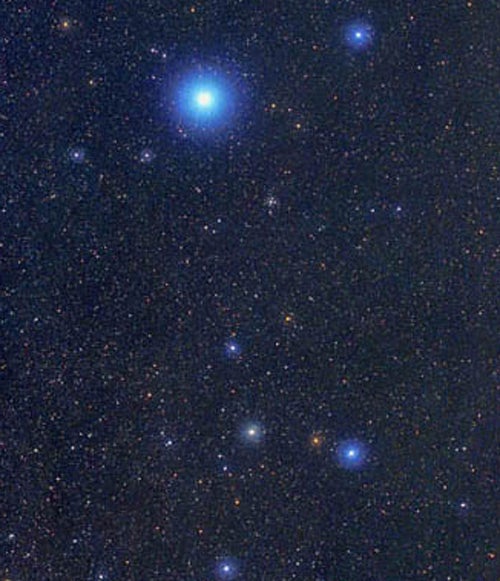The dog’s crowning glory is Sirius — the brightest star in the night sky. To locate Sirius, first find Orion when it’s high above the southern horizon. Follow a line formed by the stars in Orion’s “belt” down and to the left. Sirius sparkles above the treetops as a blue-white beacon.
To be fair to other 1st-magnitude stars Sirius so boldly outshines, the Dog Star has an unfair advantage. It’s one of our Sun’s nearest neighbors, just 8.7 light-years away.
Sirius is a famous binary star. Its companion, the “Pup,” was the first white dwarf star identified. Like all stars in this class, the Pup is a stellar corpse — the remains of a main sequence star that collapsed gravitationally. With a mass similar to our Sun packed into a sphere not much more than twice Earth’s diameter, the Pup is incredibly dense. One cubic inch of its material would weigh more than 2 tons on Earth.
Unfortunately, small-aperture telescopes don’t show the Pup. The main star’s magnitude –1.5 glare usually buries its dimmer, 8th-magnitude companion.
Telescope handbooks advise us to observe a sky object when it’s high above the horizon. Light traveling from anything near the horizon traverses more atmosphere and is, therefore, subject to more air turbulence. For Sirius, we make an exception. When this brilliant star lies near the horizon, and the atmosphere toys with its light, Sirius sparkles in a rainbow of colors — a mesmerizing sight in binoculars or a telescope.
If you live in a dark-sky area, look for a faint smudge of light about 4° (8 Full-Moon widths) below Sirius. Through binoculars, the smudge transforms into a sprinkling of faint stars — the open cluster M41.
I remember eagerly seeking out M41 in my days as a novice after learning that a red star shines near its center. I was disappointed when no such star appeared in the eyepiece field. Perhaps my beginner’s eyes weren’t trained to see the faint star’s subtle coloring. Now, I have no trouble spotting this ruddy cluster member.
One of my favorite Canis Major treats is the open cluster NGC 2362, centered on the 4th-magnitude star Tau (τ) Canis Majoris. The compact gathering of some 60 stars spans just one-fourth the apparent diameter of M41. The cluster’s appearance blew me away when I first saw it through a 3-inch reflecting telescope in February 1978. In my logbook I wrote:
- Simply gorgeous! With direct vision, appears as a group of faint stars surrounding Tau CMa. Looks like a multiple star. With averted vision, the field around Tau fairly explodes with stars, and it looks like a globular cluster.
NGC 2362 can handle higher magnifications than M41. Try 60x-100x.
If you’re a double-star aficionado, you’ll love Herschel 3945 (h3945), located about 1° north and slightly west of NGC 2362. Throughout the years, I have split more than 1,500 double and multiple stars. Of these, h3945 ranks as one of my favorites — a comfortably wide 26.6″ separates topaz-yellow and sapphire-blue gems. The rich hues make it a match for the more celebrated Albireo. Perhaps we can blame this double star’s southerly location and its relative faintness — at magnitudes 4.8 and 6.8, its components are fainter than Albireo’s.
Oddly enough, my first sighting of h3945 barely elicited mention in my logbook. It was one of my first double stars, and I surmise that, as was the case with the red star in M41, my untrained eyes failed to pick out the colors. If you’re an astronomical “rookie” and view h3945, let me know how its colors appear to you.
Okay, everyone. Bundle up, go outside, and check out the wonders Canis Major offers. You’ll be glad I sent you to the dogs.











